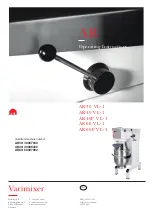
CX263 Installation and User Guide v1.1
9
INSTALLATION
Hardware Considerations
The CX263 Zone Mixer is built in a 1U-high 19” rack mount
enclosure. It is recommended that the Zone Mixer is installed
in a 19” rack wherever possible. The unit is approx. 150 mm
deep, but 250 mm of rack depth should be available to allow
for rear connectors and cabling.
The CX263 has low power consumption and there should
be no thermal problems. Other equipment may be installed
above or below the CX263.
The choice of location will be dictated by the specifics of the
system and building layout. It is recommended that wherever
possible, the CX263 should be mounted in an equipment rack
along with as many of the music sources (CD players, music
servers, TV receiver boxes, etc.) and audio power amplifiers
(driving the zone loudspeakers) as practical.
When deciding the Zone Mixer’s location, bear in mind that
access to it will probably be required even if a full complement
of remote controls is being fitted as part of the system, as
some adjustments can only be made on the mixer itself.
Power Supply
The CX263 is fitted with a Universal power supply which can
operate on mains voltages from 85 to 253 V. An IEC mains
cable with a plug appropriate for your country is supplied. The
unit’s power consumption is 10.3 W.
Fuses and ratings
The only user-accessible fuse is an AC mains fuse on the rear
panel.
Only replace a fuse with one of exactly the same
type.
The fuse rating is 1 A; the type is a T1A, size 20 x 5 mm,
with high breaking capacity.
System Connections
Music Sources
Connect the system’s various music sources to inputs
LINE 1
to
LINE 6
. The inputs are unbalanced, on standard RCA
jacks (phono sockets). All six inputs are stereo, with separate
L and R connectors. The channels are summed internally to
mono as they are fed to Zones 2 and 3, but remain separate
for the stereo Zone 1. If connecting a mono source with
only a single output, it may be connected to either the left
or the right input (but see “Zone Outputs” on page 10
re configuring Zone 1 for mono operation). The sensitivity
range available should allow most standard items of audio
equipment such as computers/tablets, music servers and
media receivers, etc., to operate at a satisfactory level.
Provided the music source is adjacent to the Zone Mixer,
normal phono-phono (or 3.5 mm jack-to-phono leads can be
used. Always avoid using pre-made leads of an unnecessary
length.
If it is necessary to connect an item of source equipment
with a balanced output, the ideal method is to use a balancing
transformer between the source and the unbalanced input.
Suitable audio transformers, which should have a ratio of 1:1,
are readily available from major audio component suppliers.
The transformer(s) should be mounted as close to the Zone
Mixer as practical, and housed in a screened enclosure if
they are not individually screened. The preferred connection
method is shown below.
LEFT
+
-
SCN
Unbalanced
inputs
SCN
LEFT
+
-
SCN
Audio balancing transformers
RIGHT
+
-
SCN
Unbalanced
inputs
SCN
RIGHT
+
-
SCN
pin 1 ground
pin 2 hot
pin 3 cold
Balanced outputs (XLRs):
1
2
3
1
2
3
If transformers are not available, a balanced source may feed
an unbalanced input directly as long as care is taken over how
the connections are made. A variety of design techniques are
in use to implement balanced outputs in audio equipment,
and some designs require different wiring protocols to others.
Installers are advised to check the manuals with each item
for guidance on how the outputs should be connected to an
unbalanced input.
However, the wiring method shown below will work in a large
number of cases:
Unbalanced
inputs
LEFT
RIGHT
+
+
-
-
SCN
SCN
+
+
-
-
SCN
SCN
When using twin-and-screen
cable, join ‘cold’ to screen at
CX263 end
LEFT
RIGHT
pin 1 ground
pin 2 hot
pin 3 cold
Balanced outputs (XLRs):
1
2
3
1
2
3








































